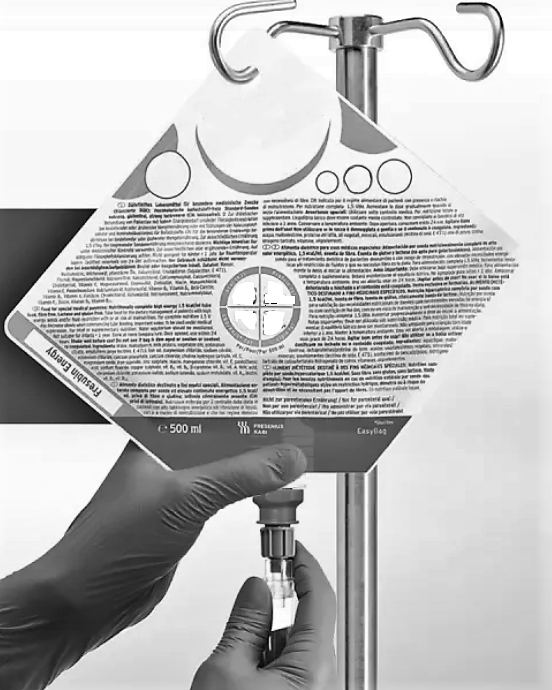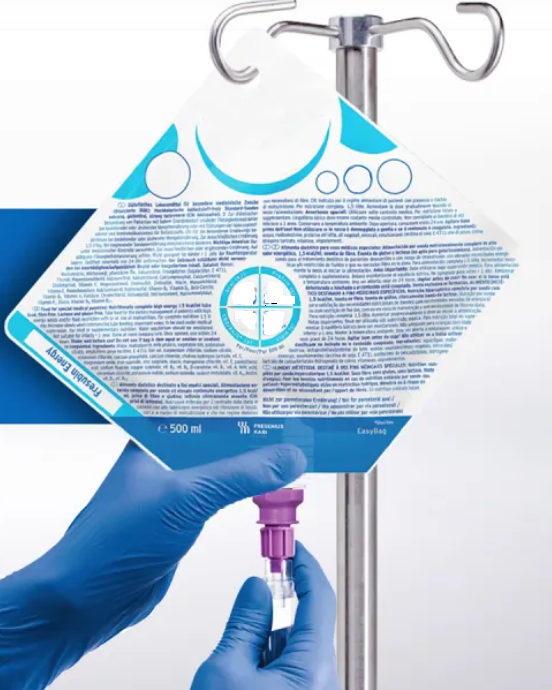ENTERAL RTU, hypercal. child, normo prot., fibre 0.5l
Valid Article
ENTERAL READY TO USE, Child
Definition
Enteral Nutrition is the administration of nutritionally complete food (containing proteins, carbohydrates, fats, minerals and vitamins adapted to the patient's needs), directly into the stomach, duodenum or jejunum. It is administered via a nasogastric or nasoenteral tube, either by gravity or with a pump.
Enteral nutrition products are intended for children up to 14 years of age who are unable to swallow. Oral drinks (oral route) are intended for patients who can swallow. Ready-to-use enteral nutrition products should not be consumed orally, as their taste is not suitable for oral nutrition (disgusting).
Specifications
Ready-to-use enteral nutrition products can be used either as a complete diet or as a nutritional supplement for tube feeding only.
There are different types of ready-to-use enteral products for children, classified according to several criteria:
- Based on calories intake:
- isocaloric: 1 kcal/ml (NFOSENIC+++ codes), for children without high energy requirements, who are not undernourished or at risk of undernutrition (e.g., in the initial phase of re-feeding), or for those without hypercatabolic or hypermetabolic state.
- hypercaloric: 1.5 kcal/ml (NFOSERHC+++ codes), for children with high energy requirements, those who are malnourished, or those in a hypercatabolic state (e.g., burn patients).
- Based on proteins form:
- Most enteral nutrition products for children are normo-protein (NP in the code), with proteins providing 8-10% of total energy
- Semi-elemental forms contain hydrolysed or partially hydrolysed (pre-digested) proteins (NFOSERICSE+++ codes)
- Based on fibre content:
- Products may contain fibre (F in the code) or no fibre (W in the code)
Technical specifications
Enteral nutrition products are generally lactose free and gluten free.
| Nutritional properties | ISOCALORIC Child (NFOSENICNPW05) | HYPERCALORIC Child (NFOSERHCNPF05) |
| Energy | 100 kcal/100 ml | 150 kcal/100 ml |
| Proteins: 8-10% energy | 2-2.5 g/100 ml | 3-3.8 g/100 ml |
| Lipids: 40% energy | 4.5 g/100 ml | 6.7 g/100 ml |
| Carbohydrates: 48-50% energy | 12.5 g/100 ml | 18 g/100 ml |
| Fibres | absence | 10-15 g |
| Example | frebini original, sondialis standard junior | frebini energy fibre, nutrinimax energy multifibre |
Remarks:
- Semi-elemental products are higher in proteins (11-12% of total energy): 2.8-3 g/100 ml. The powder formualtion (NFOSDEICSEWV4) (peptamen junior) has a longer shelf life, is less expensive and versatile (suitable for both oral and enteral nutrition). Check with your supply centre if it is available before placing any orders.
- Only standard articles are listed. Contact your pharmacist or nutrition referent if you need the code of a non-standard article (e.g. isocal with fibres, hypercal without fibre...).
Packaging & Labelling
Primary and secondary packaging must protect the hygienic and nutritional qualities of the product during transport, handling, storage under MSF field conditions.
- Primary packaging (unit packaging): 500 ml ready-to-use bag
For more information on packaging labelling, refer to the CHECKLIST CONTROL UPON RECEIPT specialised food.
Instructions for use
- Always read the instructions on the product and tubes packaging.
- Ready-to-use enteral nutrition products should be replaced every 24 hrs (and discarded after 24 hrs).
- Enteral nutrition products can only be administered by enteral route (via tube), and under medical supervision. Do not administer by parenteral route.
- Enteral nutrition products are ready-to-use. Do not dilute.
- Do not add medicines or any other substances.
Storage
- Below 25ºC
- Shelf life: 12 months
Caution! The main risk of deterioration is a loss of nutritional and organoleptic properties, due to bad storage conditions (>30°C).
Follow the procedure QA-NFOS-SOP3 Storage of specialised food (NFOS).
For procedures related to Quality Control, refer to Preliminary remarks on specialised food.





![[KMEDMHIE231] (mod ICU) SPECIALIZED NUTRITION 2021](/web/image/product.template/574341/image_256/%5BKMEDMHIE231%5D%20%28mod%20ICU%29%20SPECIALIZED%20NUTRITION%202021?unique=ae0d872)
![[EEMDENPC102] (pump Flocare) ADMINISTRATION SET, ENFit, ster.,s.u. 586514](/web/image/product.template/573221/image_256/%5BEEMDENPC102%5D%20%28pump%20Flocare%29%20ADMINISTRATION%20SET%2C%20ENFit%2C%20ster.%2Cs.u.%20586514?unique=042abef)
![[EEMDENPE1--] ENTERAL NUTRITION PUMP (Flocare Infinity) 230V with battery](/web/image/product.template/570854/image_256/%5BEEMDENPE1--%5D%20ENTERAL%20NUTRITION%20PUMP%20%28Flocare%20Infinity%29%20230V%20with%20battery?unique=d842022)
![[NSFSCRECOSE] CHECKLIST CONTROL UPON RECEIPT specialised food, English](/web/image/product.template/572035/image_256/%5BNSFSCRECOSE%5D%20CHECKLIST%20CONTROL%20UPON%20RECEIPT%20specialised%20food%2C%20English?unique=7561dd3)
![[NSFSCRECOSF] CHECKLIST CONTROL UPON RECEIPT specialised food, French](/web/image/product.template/572046/image_256/%5BNSFSCRECOSF%5D%20CHECKLIST%20CONTROL%20UPON%20RECEIPT%20specialised%20food%2C%20French?unique=7561dd3)
![[SCTDAENG1--] ADMINISTRATION SET EN, gravity, ENPlus/ENFit, ster.,s.u.](/web/image/product.template/571924/image_256/%5BSCTDAENG1--%5D%20ADMINISTRATION%20SET%20EN%2C%20gravity%2C%20ENPlus-ENFit%2C%20ster.%2Cs.u.?unique=b469e50)
![[SCTDTUGF06-] NASOGASTRIC TUBE, ENFit tip, s.u., 50 cm, CH06, light green](/web/image/product.template/571563/image_256/%5BSCTDTUGF06-%5D%20NASOGASTRIC%20TUBE%2C%20ENFit%20tip%2C%20s.u.%2C%2050%20cm%2C%20CH06%2C%20light%20green?unique=717fefd)
![[SCTDTUGF08-] NASOGASTRIC TUBE, ENFit tip, s.u., 50 cm, CH08, blue](/web/image/product.template/571562/image_256/%5BSCTDTUGF08-%5D%20NASOGASTRIC%20TUBE%2C%20ENFit%20tip%2C%20s.u.%2C%2050%20cm%2C%20CH08%2C%20blue?unique=332851b)
![[SCTDTUGF10-] NASOGASTRIC TUBE, ENFit tip, s.u., 50 cm, CH10, black](/web/image/product.template/571565/image_256/%5BSCTDTUGF10-%5D%20NASOGASTRIC%20TUBE%2C%20ENFit%20tip%2C%20s.u.%2C%2050%20cm%2C%20CH10%2C%20black?unique=717fefd)